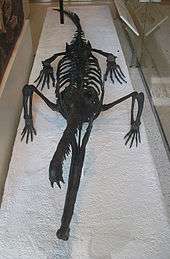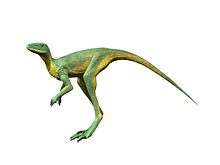Rutiodon
Rutiodon ("Wrinkle tooth") is an extinct genus of archosaur belonging to the family Phytosauridae. It lived during the Late Triassic period, and was about 3 to 8 meters in length.[1] Rutiodon is known from the eastern United States (North Carolina, New York, New Jersey).[2]
| Rutiodon | |
|---|---|
| Skeleton of Rutiodon carolinensis (AMNH 1) in the American Museum of Natural History | |
| Scientific classification | |
| Kingdom: | Animalia |
| Phylum: | Chordata |
| Class: | Reptilia |
| Order: | †Phytosauria |
| Family: | †Phytosauridae |
| Genus: | †Rutiodon Emmons, 1856 |
| Species | |
| |
| Synonyms | |
| |
Description


Like other phytosaurs, Rutiodon strongly resembled a crocodile, but its nostrils were positioned far back on the head, close to the eyes, instead of at the tip of the snout. It had enlarged front teeth, and a relatively narrow jaw, somewhat resembling that of a modern gharial. This suggests that this carnivore probably caught fish and it may also have snatched land animals from the waterside.[1] Also, like modern crocodiles, its back, flanks, and tail were covered with bony armored plates.[3]
Rutiodon was among the largest carnivorous animals of its environment, measuring 3–8 meters (10–26 ft) in length.
Species


The type species of Rutiodon is R. carolinensis. A second species, R. manhattanensis, was discovered in 1910 near Fort Lee, New Jersey, and named in reference to its close proximity to Manhattan.
Phylogeny
Below is a cladogram from Stocker (2012):[4]
| Phytosauria |
| |||||||||||||||||||||||||||||||||||||||||||||||||||||||||||||||||||||||||||||||||||||||||||||
References
- Gaines, Richard M. (2001). Coelophysis. ABDO Publishing Company. p. 21. ISBN 1-57765-488-9.
- Michelle R. Stocker (2010). "A new taxon of phytosaur (Archosauria: Pseudosuchia) from the Late Triassic (Norian) Sonsela Member (Chinle Formation) in Arizona, and a critical reevaluation of Leptosuchus Case, 1922". Palaeontology. 53 (5): 997–1022. doi:10.1111/j.1475-4983.2010.00983.x.CS1 maint: uses authors parameter (link)
- Palmer, D., ed. (1999). The Marshall Illustrated Encyclopedia of Dinosaurs and Prehistoric Animals. London: Marshall Editions. p. 95. ISBN 1-84028-152-9.
- Stocker, M. R. (2012). "A new phytosaur (Archosauriformes, Phytosauria) from the Lot's Wife beds (Sonsela Member) within the Chinle Formation (Upper Triassic) of Petrified Forest National Park, Arizona". Journal of Vertebrate Paleontology. 32 (3): 573–586. doi:10.1080/02724634.2012.649815.
External links
- Geological report of the midland counties of North Carolina by Ebenezer Emmons. New York, G.P. Putnam & Co.; Raleigh, H.D. Turner, 1856.
- http://www.paleodirect.com/phyto1.htm
- https://web.archive.org/web/20070501202333/http://www.dinosaurcollector.150m.com/NewBlood.html









